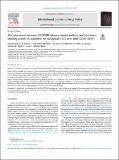Files in this item
The association between MPOWER tobacco control policies and adolescent smoking across 36 countries : an ecological study over time (2006–2014)
Item metadata
| dc.contributor.author | de Looze, Margaretha E. | |
| dc.contributor.author | Henking, Christoph | |
| dc.contributor.author | Torsheim, Torbjoern | |
| dc.contributor.author | Currie, Dorothy B. | |
| dc.contributor.author | Weber, Martin W. | |
| dc.contributor.author | Alemán-Díaz, Aixa Y. | |
| dc.date.accessioned | 2022-10-27T15:30:16Z | |
| dc.date.available | 2022-10-27T15:30:16Z | |
| dc.date.issued | 2022-11-01 | |
| dc.identifier | 281894152 | |
| dc.identifier | 0ca5251c-904c-4678-af5f-6e82d86a1a92 | |
| dc.identifier | 85139259821 | |
| dc.identifier | 000882782100002 | |
| dc.identifier.citation | de Looze , M E , Henking , C , Torsheim , T , Currie , D B , Weber , M W & Alemán-Díaz , A Y 2022 , ' The association between MPOWER tobacco control policies and adolescent smoking across 36 countries : an ecological study over time (2006–2014) ' , International Journal of Drug Policy , vol. 109 , 103871 . https://doi.org/10.1016/j.drugpo.2022.103871 | en |
| dc.identifier.issn | 0955-3959 | |
| dc.identifier.other | Jisc: 642413 | |
| dc.identifier.other | ORCID: /0000-0001-7321-9394/work/121754236 | |
| dc.identifier.uri | https://hdl.handle.net/10023/26262 | |
| dc.description.abstract | Objective To examine associations over time between national tobacco control policies and adolescent smoking prevalence in Europe and Canada. Design In this ecological study, national tobacco control policies (MPOWER measures, as derived from WHO data) in 36 countries and their changes over time were related to national-level adolescent smoking rates (as derived from the Health Behaviour in School-aged Children study, 2006-2014). MPOWER measures included were: Protecting people from tobacco smoke (P), offering help to quit tobacco use (O), warning about the dangers of tobacco (W), enforcing bans on advertising, promotion and sponsorship (E) and raising taxes on tobacco (R). Results Across countries, adolescent weekly smoking decreased from 17.7% in 2006 to 11.6% in 2014. It decreased most strongly between 2010 and 2014. Although baseline MPOWER policies were not directly associated with differences in average rates of adolescent smoking between countries, countries with higher baseline smoke-free policies (P) showed faster rates of change in smoking over the time period. Moreover, countries that adopted increasingly strict policies regarding warning labels (W) over time, faced stronger declines over time in adolescent weekly smoking. Conclusion A decade after the introduction of the WHO MPOWER package, we observed that, in our sample of European countries and Canada, measures targeting social norms around smoking (i.e., smoke-free policies in public places and policies related to warning people about the dangers of tobacco) are most strongly related to declines in adolescent smoking. | |
| dc.format.extent | 7 | |
| dc.format.extent | 835085 | |
| dc.language.iso | eng | |
| dc.relation.ispartof | International Journal of Drug Policy | en |
| dc.subject | HA Statistics | en |
| dc.subject | RA0421 Public health. Hygiene. Preventive Medicine | en |
| dc.subject | 3rd-DAS | en |
| dc.subject | SDG 3 - Good Health and Well-being | en |
| dc.subject | AC | en |
| dc.subject | MCC | en |
| dc.subject.lcc | HA | en |
| dc.subject.lcc | RA0421 | en |
| dc.title | The association between MPOWER tobacco control policies and adolescent smoking across 36 countries : an ecological study over time (2006–2014) | en |
| dc.type | Journal article | en |
| dc.contributor.institution | University of St Andrews. School of Medicine | en |
| dc.contributor.institution | University of St Andrews. Population and Behavioural Science Division | en |
| dc.identifier.doi | https://doi.org/10.1016/j.drugpo.2022.103871 | |
| dc.description.status | Peer reviewed | en |
This item appears in the following Collection(s)
Items in the St Andrews Research Repository are protected by copyright, with all rights reserved, unless otherwise indicated.

